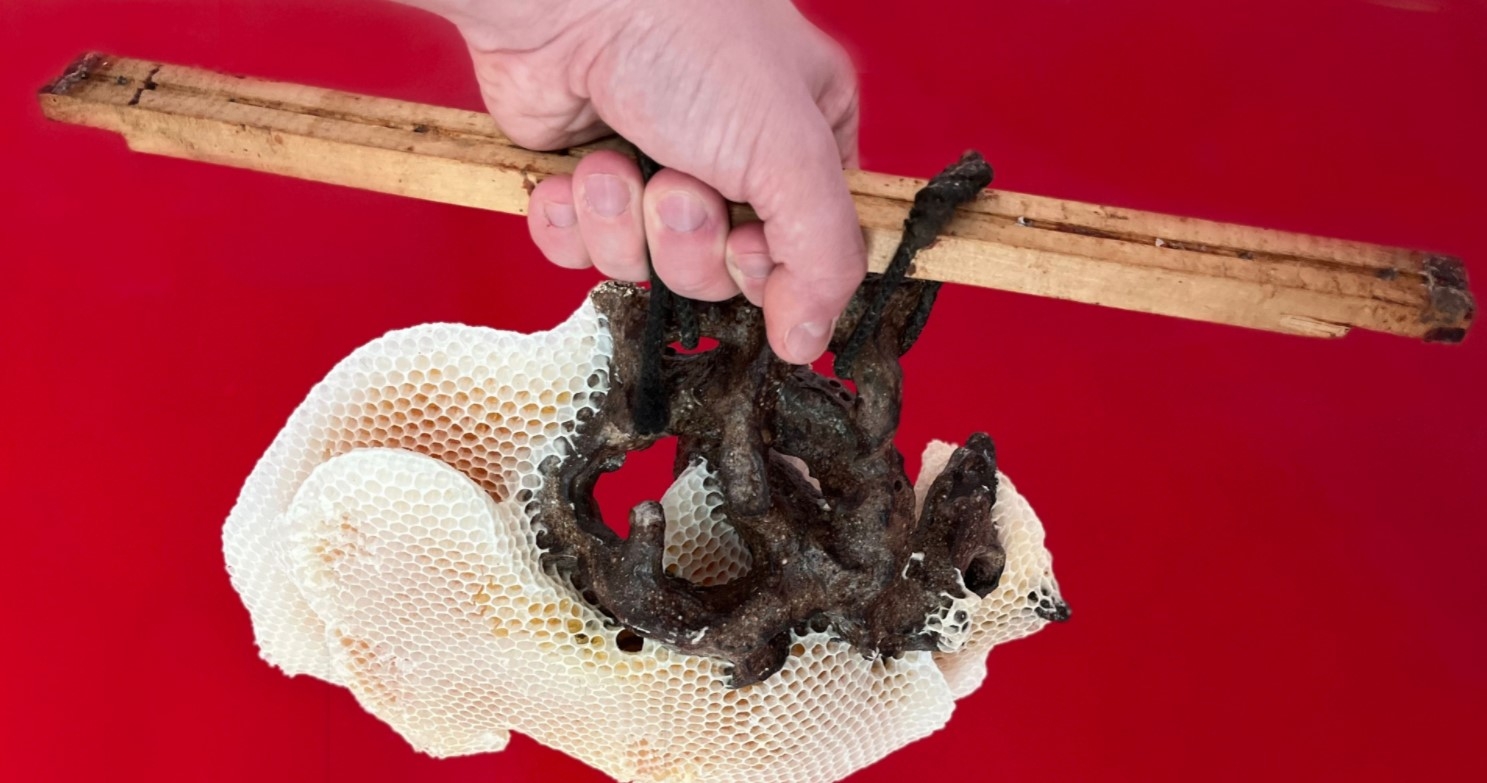At the end of the gallery, Rasmus Myrup’s installation invites us to sit within a warped forest, from which the works of Eirik Falckner and Kjersti Sundland can be experienced. Two hybrid ceramic sculptures by Falckner are mounted in the gallery. They are the result of a collaboration with local beekeeper Johannes Gudolv Irgens, to whom the sculptures were offered – for a colony of bees to temporally overtake the works, forming a new habitat for their hive. When these sculptures are presented to us, the absence of the insects suggests an audible presence, as if the works are speakers now silenced. Kjersti Sundland presents a two-screen installation consisting of one screen-printed work resembling a root structure, and one video projection that draws its source material from just outside of the gallery space. Sundland’s work also has an auditive aspect, which reacts to the activity inside the gallery space. The works here seem to be conducted by an uncertain presence.
As in Sundland’s work, the artist duo Nicholas Grafia & Mikołaj Sobczak do not confine their presentation to the physical limits of Hordaland Kunstsenter. Through a performance taking place at Landmark, and a podcast made available during evening listening sessions, their work intertwines stories from different families and explores the tension between parent figures and their designated offspring, as well as notions of love, hate, desire and regret. The protagonists of the performance are Slavic and Philippine folk demons who were used to embody the feelings of being viewed as the other, of not fitting into a community.
Drawing upon the cinematic genre classified as folk horror the works included in the exhibition suggest a history buried beneath the face of civility – a presence of something ancient, an uncomfortable kind of nature that science and technology struggles to cope with.
The invitation extended through the exhibition could also be to reposition oneself through shifts of glitches, occupancy or upending, leaving our understanding of that what is considered rational, outside. We Meet at Dusk holds a kind of magic that is supported through infrastructure, not disregarding the world in which it resides. Even so – perhaps there is a mischievous fairy interfering with and tweaking the works, fiddling with watches, and opening the doors to the gallery after regular hours?
We Meet At Dusk introduces artworks that questions and challenges the idea of time. The mediation program following the exhibition also suggests a change of pace and to take a contemplative seat, through reading sessions, gatherings at dusk, film screenings and tuning in to radio broadcasts. As we wait for the sun to go down, the audience is invited to step out of traditional time structures.
Curated by Scott Elliott and Daniela Ramos Arias
ARTISTS
NICHOLAS GRAFIA & MIKOŁAJ SOBCZAK
Nicholas Grafia & Mikołaj Sobczak render public scenarios and site-specific situations, in which figures such as vampires, zombies, witches and healers are used as narrative and visual vehicles, in order to relate characteristics and stigmas attached to them to modern societies and their hostile ways of politically and socially alienating certain parts of their respective demographics. Their work pushes against the homogeneity often associated with folk horror tales and acknowledges the diversity of a migratory, contemporary world as the work re-appropriates folk tales within a global and queer perspective.
Nicholas Grafia & Mikołaj Sobczak’s work It’s 10PM. Do you know where your children are? will take place at Landmark, Bergen Kunsthall on March 27th at 20:00.
EIRIK FALCKNER
Eirik Fackner’s work plays on the fear of the unknown, what one imagines can exist in the depths of the ocean and in space. A recurring theme in Falckner’s practice is a sense of transience, as a human being in the face of the powerful and prehistoric nature that forms our basis of life. In this exhibition, Falckner presents two sculptures that have been taken over by beehives, along with one larger monolith ceramic piece with a tentacular presence. These almost parasitic pieces are preoccupied by what seeds are taking root, how the hive is developing and less by the rush of peripheral noise or urgency other than that of the pace bees.
RASMUS MYRUP
Rasmus Myrup’s work is a synthesis of the big and the small. Informed by our evolutionary history and our belonging to the natural world, he investigates the arc of humanity’s natural roots in the context of personal human emotions and relations. For Hordaland Kunstsenter, Myrup has constructed a site-specific work that positions nature as a stage and congregation point for different temporalities, modes of exchange that encourage a different pace or perspective shift, one that glitches with human interference.
KJERSTI SUNDLAND
Kjersti Sundland works within a collaborative and research based methodology. Inspired by feminist philosophies, Sundland explores through video, live performances and time-based installations how the history of technology and occult practices are intertwined and influence our conceptions of gender. Sundland’s work presented here speaks to the idea that ghosts or hauntings are recordings embedded within spaces, transmissions that parasite or activate works in different states. Rational language becomes more of a blueprint, but allows for neurological mechanisms behind the process of visions and dreams to emerge.




